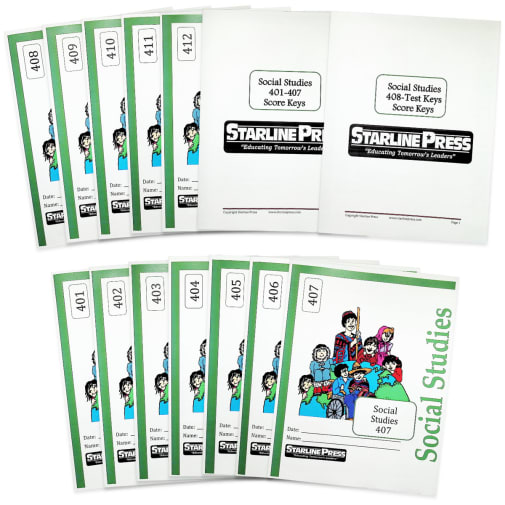California history from 1900 to present is studied as well as the geography of California, including physical characteristics and regions. The Gold Rush and the effects it had on California are also discussed. California history, federal, state and local government is also studied. They will also learn to identify early explorers and focus on key time periods, such as Spanish and Mexican rule. Students will organize and write a report on the history of California.
Starline Press Social Studies 4th Grade Set
Description
The fourth grade social studies student learns the geography of California, including physical characteristics and regions. The student distinguishes early explorers, and focuses on key time periods, such as Spanish and Mexican rule. Students study the effects of the Gold Rush and how it changed California. Fourth grade students learn of California from 1900 to the present. They organize and write a report on the history of California.
Starline Press is a character-based, state standards aligned, individualized and independent learning curriculum. Social Studies programs cover grade specific social studies topics including history, geography, citizenship, government and economics. Aligned to state standards, including California, each grade level provides self-directed instruction with minimal teacher supervision. Grades 3-8 complete twelve units (booklets) per year, with a suggested 3 week completion time frame. Grades 9-12 complete 5 booklets per semester or 10 per year.
Grade 12 Economics studies the role of government, international trade policy, poverty and privatization. Students learn about small business, franchising, chain stores, the sole proprietor and business partnerships. Government is also studied in twelfth grade and probes the impact of history on our government and federalism. Students study forms of government, the Constitution and Bill of Rights, and branches of government.
Consumable booklets are colorfully illustrated soft cover, although newer printings are more like booklets and do not have the perfect binding and glossy covers. Each grade level incorporates vocabulary lists, fill in the blank questions, chapter reviews, and unit tests, and writing assignments including reports and term papers. Please see publisher website for CA state standards correlation. Sold only as complete sets which include answer and test keys. ~ Deanne
| Product Format: | Softcover Book Set |
|---|---|
| Grade: | 4 |
| Brand: | Starline Press |
| Length in Inches: | 11 |
| Width in Inches: | 8.5 |
| Height in Inches: | 2 |
| Weight in Pounds: | 3.1813 |

